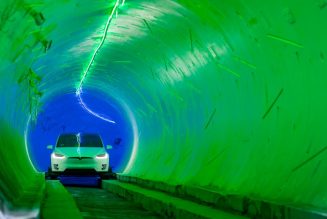For the first time, researchers have created a fusion reaction that resulted in a net energy gain. The results, from the Lawrence Livermore National Laboratory in California, mark a significant step on the very long road toward generating clean energy from nuclear fusion.
“Last week, lo and behold, indeed, they shot a bunch of lasers at a pellet of fuel, and more energy was released from that fusion ignition than the energy of the lasers going in,” White House Office of Science and Technology Policy Director Arati Prabhakar said at a press conference announcing the achievement in Washington, DC, today. “I just think this is such a tremendous example of what perseverance really can achieve.”
“A tremendous example of what perseverance really can achieve”
Nuclear fusion happens when atoms crash into each other, “fusing” to create a heavier atom and releasing energy in the process. In the sun and other stars, hydrogen nuclei fuse together, creating helium and generating enormous amounts of energy. To achieve nuclear fusion on Earth, humans have to heat atoms to tremendous temperatures — millions of degrees Celsius, which is why it’s been so daunting to reach a net energy gain.
In this case, at 1:03AM local time on December 5th, the national laboratory used 192 powerful laser beams to hit a solid target of hydrogen isotopes that’s only about the size of a peppercorn. The target is enclosed in a meticulously crafted diamond shell.
:format(webp)/cdn.vox-cdn.com/uploads/chorus_asset/file/24288625/X_rays.jpeg)
“Today’s shells are almost perfectly round. They are 100 times smoother than a mirror, and they have a tiny tube attached to them that’s about a 50th the diameter of a hair through which the fuel is filled into the shell,” said Michael Stadermann, Target Fabrication Program manager at Lawrence Livermore National Laboratory. “As you can imagine, perfection is really hard, and so we’ve yet to get there — we still have tiny flaws on our shells, smaller than bacteria.”
The experiment produced 3.15 megajoules of energy, about 50 percent more than the 2.05 megajoules the lasers used to trigger the reaction. By doing so, reaching a scientific energy breakeven, the researchers achieved what’s called “fusion ignition.”
Harnessing nuclear fusion could be revolutionary — giving people an abundant energy source without the nasty side effects of greenhouse gas emissions or long-lasting radioactive waste. Doing so, however, depends on overcoming huge engineering hurdles. After decades of experimentation, today’s announcement represents a small but significant victory over one of those hurdles. But there is still a long, long way to go before nuclear fusion can fulfill any clean energy dreams.
The US government has been funding fusion energy research since the 1950s. Across the world, the pursuit has garnered tens of billions of dollars in funding. And by late last year, scientists with the Joint European Torus (JET) in the UK had generated a record 59 megajoules of energy from nuclear fusion. The big problem is that until now, nuclear fusion in a lab hadn’t been able to generate more energy than it took to make the reaction happen in the first place.
It’s a key milestone, but there are still some important caveats to note. One key point is that the DOE is basing this victory on just the output of the lasers, which are pretty inefficient. It takes 300 megajoules of energy from the grid just to get those two megajoules of laser energy. So today’s announcement hinges on a limited definition of “net energy gain.”
Lasers aren’t the only way to achieve nuclear fusion. Other efforts, including JET, involve a magnetic device called a Tokamak to confine and heat up plasma. Whatever the method, we’re likely decades away from generating energy this way at a power plant. It’s going to take a lot more money and incremental wins to get there, today’s announcement being one of them.
“With real investment and real focus, that timescale can move closer,” Kim Budil, Lawrence Livermore National Laboratory director, said at the press conference. “We were in a position for a very long time where it never got closer, right? Because we needed this first fundamental step. So we’re in a great position today to begin understanding just what it will take to make that next step.”
For starters, scientists need to be able to reach ignition again. “This is one igniting capsule, one time. To realize commercial fusion energy, you have to do many things; you have to be able to produce many, many fusion ignition events per minute,” Budil said. “There are very significant hurdles, not just in the science but in technology.”
One hurdle is that the lasers used in any future efforts need to be way more efficient. The system used in this experiment, called the National Ignition Facility, is the largest and highest-energy laser in the world — bigger than three football fields. But it’s still based on 1980s technology. Modern lasers are more efficient, and future efforts will probably try to incorporate newer tech into experiments.
“This demonstrates it can be done. That threshold being crossed allows them to start working on better lasers, more efficient lasers, on better containment capsules, etc.,” Budil said. “We need the private sector to get in the game. It’s really important that there has been this incredible amount of US public dollars going into this breakthrough, but all of the steps that we’ll take that will be necessary to get this to commercial level will still require public research and private research.”









